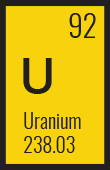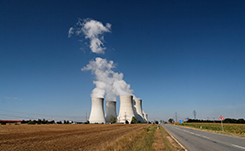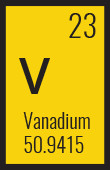Uranium was discovered by Martin Heinrich Klaproth, a German chemist, in the mineral pitchblende (primarily a mix of uranium oxides) in 1789. Although Klaproth, as well as the rest of the scientific community, believed that the substance he extracted from pitchblende was pure uranium, it was actually uranium dioxide (UO2). After noticing that 'pure' uranium reacted oddly with uranium tetrachloride (UCl4), Eugène-Melchoir Péligot, a French chemist isolated pure uranium by heating uranium dioxide with potassium in a platinum crucible. Radioactivity was first discovered in 1896 when Antoine Henri Becquerel, a French physicist, detected it from a sample of uranium.


Since it is naturally radioactive, uranium, usually in the form of uranium dioxide (UO2), is most commonly used in the nuclear power industry to generate electricity. Naturally occurring uranium consists of three isotopes: uranium-234, uranium-235 and uranium-238. Although all three isotopes are radioactive, only uranium-235 is a fissionable material that can be used for nuclear power.
Vanadium is a chemical element with symbol V and atomic number 23. It is a hard, silvery grey, ductile and malleable transition metal. The element is found only in chemically combined form in nature, but once isolated artificially, the formation of an oxide layer stabilizes the free metal somewhat against further oxidation.
Andrés Manuel del Río discovered compounds of vanadium in 1801 in Mexico by analyzing a new lead-bearing mineral he called "brown lead," and presumed its qualities were due to the presence of a new element, which he named erythronium (Greek for "red") since, upon heating, most of its salts turned from their initial color to red. Four years later, however, he was (erroneously) convinced by other scientists that erythronium was identical to chromium.


Vanadium occurs naturally in about 65 different minerals and in fossil fuel deposits. It is produced in China and Russia from steel smelter slag; other countries produce it either from the flue dust of heavy oil, or as a byproduct of uranium mining. It is mainly used to produce specialty steel alloys such as high-speed tool steels. The most important industrial vanadium compound, vanadium pentoxide, is used as a catalyst for the production of sulfuric acid.